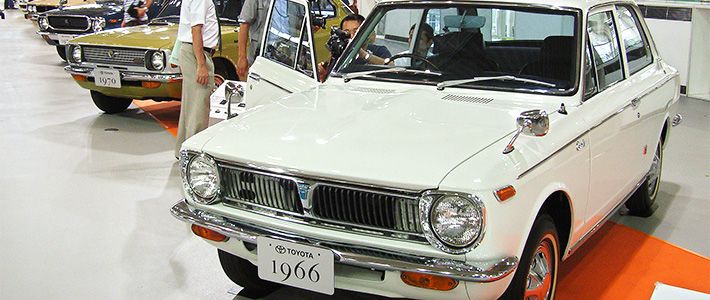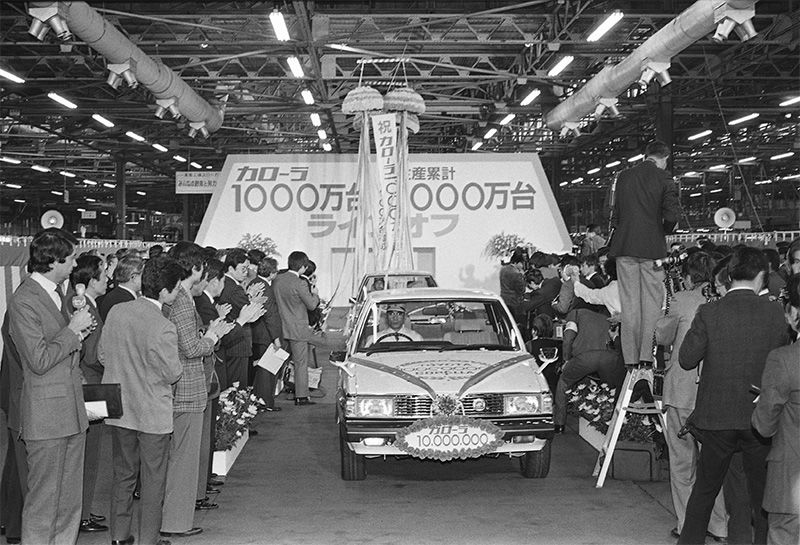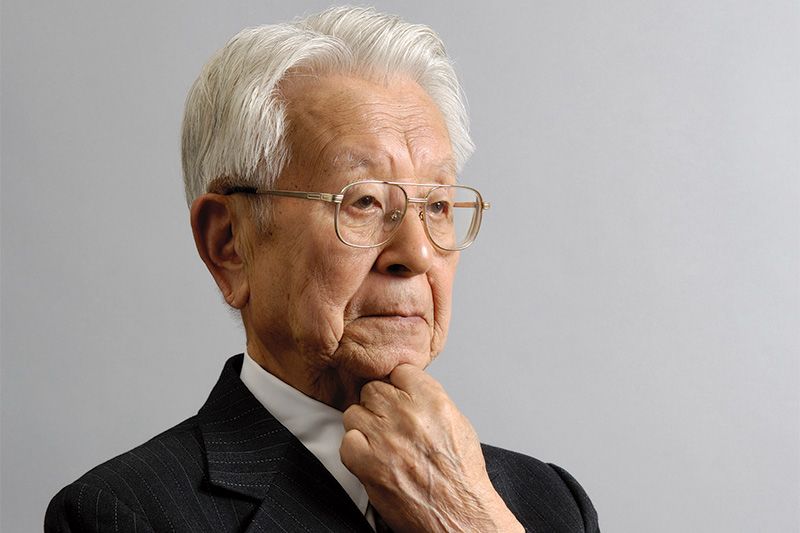
Toyota Corolla Celebrates Its Fiftieth Birthday
Economy- English
- 日本語
- 简体字
- 繁體字
- Français
- Español
- العربية
- Русский
Launched in October 20, 1966, Toyota Motor’s Corolla has been an integral part of Japan’s automotive landscape over the past 50 years. The Corolla contributed to the spread of passenger vehicles in Japan and became hugely popular around the world. Cumulative sales of this recurring top global seller reached 44 million vehicles as of August 31, 2016. Corolla’s history spanning a half century parallels the growth of Japan’s auto industry as it overcame difficult challenges and made dramatic advances.
 A ceremony at the Toyota Motor Takaoka Plant in the city of Toyota, Aichi Prefecture, celebrating the 10 millionth Corolla rolling off the production line in March 1983. (© Jiji.)
A ceremony at the Toyota Motor Takaoka Plant in the city of Toyota, Aichi Prefecture, celebrating the 10 millionth Corolla rolling off the production line in March 1983. (© Jiji.)
The first-generation Corolla released in October 1966 was a two-door sedan with a 1,100 cc engine priced at ¥432,000 (standard model in the Tokyo area). This year heralded the era of privately owned automobiles in Japan. Just a few months earlier in April, Nissan launched the Sunny, a two-door sedan with a 1,000 cc engine. Toyota’s entry into the family car segment spurred a fierce rivalry between the two leading automakers, centered on the Corolla and the Sunny. New car sales in Japan in 1966 was 2 million, but it quickly doubled to 4 million in 1970, highlighting how the Corolla and Sunny drove market growth.
Beating the Sunny with a Bigger Engine
For Toyota, the Corolla was an epoch-making model that contributed significantly to the future expansion of its business through the creation of new technologies and development approaches. Hasegawa Tatsuo (1916–2008), who later became the company’s senior managing director, was the chief engineer leading its development. Two decades ago I had an opportunity to interview Hasegawa, who had already retired, and hear firsthand accounts of Corolla’s development.
 Hasegawa Tatsuo, chief engineer for the first-generation Corolla (courtesy of Toyota Motor).
Hasegawa Tatsuo, chief engineer for the first-generation Corolla (courtesy of Toyota Motor).
The Corolla appeared with an uncommon engine displacement of 1,100 cc. This engine size was selected after it became known that Nissan’s new model—to be called Sunny on the basis of a public contest in 1965—would have a 1,000 cc engine. Although a 1,000 cc engine was initially planned for the Corolla as well, since Sunny was to be launched first, a decision was quickly made to increase the engine size by 100 cc. Over the course of several months before market launch, the development team succeeded in changing the engine design and in preparing for production. Once the Corolla was released, ads touted the “extra 100 cc” of power—a direct jab at the Sunny. This proved to be a successful advertising ploy, and many more consumers opted for the Corolla.
Making the Grade, and Then Some
What became the greatest challenge for Hasegawa was not the change in engine size but the MacPherson strut suspension that he planned to use on the front wheels—a first for a vehicle in Japan. This suspension system using coil springs and shock absorbers is now a standard feature in most automobiles. The system was developed by Earle MacPherson, an engineer at Ford Motor, in 1950. The first mass-produced car using the MacPherson strut was a model built by Ford UK for the European market. Compared to the leaf spring suspension common at the time, the MacPherson strut offered a better ride, was more compact, and weighed less.
Hasegawa was determined to use this technology in the Corolla. He traveled abroad to make technology surveys and asked Ford Japan if he could look at relevant materials. Ford Japan was happy to cooperate. It generously granted Hasegawa access to whatever he found useful in applying the technology in Japan.
The development process, though, remained an uphill struggle. In a publication chronicling Toyota’s first 75 years, Hasegawa is quoted as saying, “We became really worried when the first strut bar prototype broke down after only 500 kilometers. We eventually perfected it, though, after many design changes.”
Hasegawa was guided by the “80 points plus” doctrine of Corolla’s development, according to which a car must achieve a customer satisfaction rating of 80 points or higher in all aspects, with a number of special features scoring 90 points or higher. Such special features in the first-generation Corolla included the strut suspension system, a sporty floor shift, and a four-speed manual transmission at a time when most transmissions featured only three speeds.
Continued Popularity in Foreign Markets
Toyota established a chief engineer system for the development of the first-generation Crown, launched in 1955. Inspired by the chief designer system used in aircraft development, the chief engineer system assigned authority and responsibility for development to a single leader rather than to a council. Other automakers learned about Toyota’s use of the chief engineer system for the development of the Corolla, and today, all Japanese automakers organize new model development according to this system.
The current Corolla on the Japanese market is an eleventh-generation model that was fully redesigned in 2012, and some 110,000 units were sold in Japan in 2015. Sales of the former bestseller has now been eclipsed by such hybrid models as the Prius and Aqua, but Toyota sells the Corolla in more than 150 markets around the world—a geographic distribution that is larger than for any other Toyota model. Corollas are also manufactured in 13 countries and regions, and in 2015, 1.2 million Corollas were sold overseas, accounting for one in six vehicles Toyota sold in foreign markets.
Konishi Yoshiki, chief engineer of the next-generation Corolla, says he hopes to maintain the Corolla’s global appeal of reliability, practicality, and good value while achieving further improvements in environmental, energy, and safety features. He also wishes to design a model that is fun and stylish so the Corolla can one day celebrate its 100th anniversary.
 The current eleventh-generation Corolla (photo by the author).
The current eleventh-generation Corolla (photo by the author).